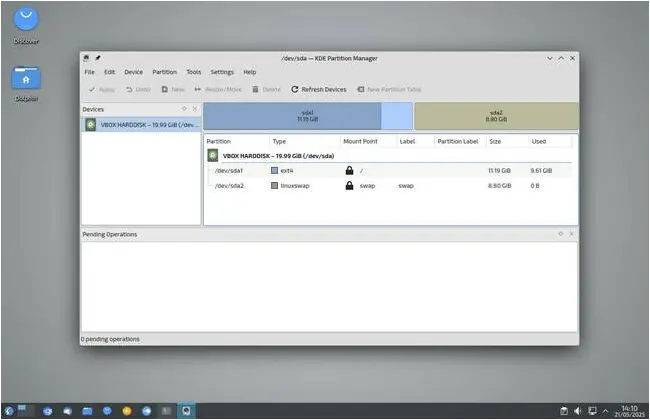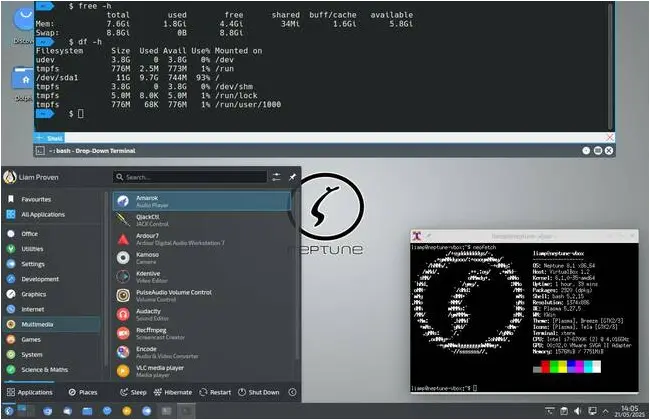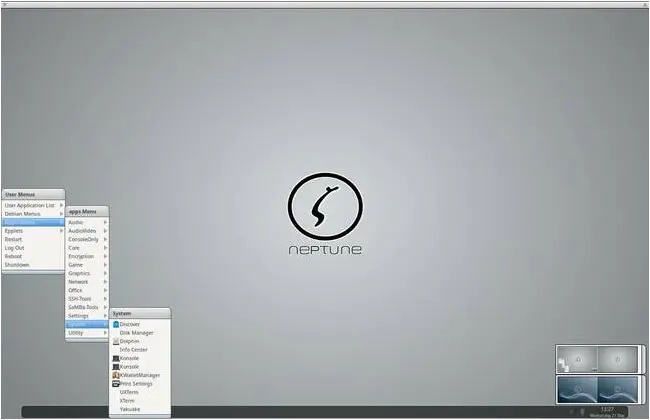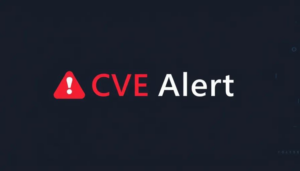Neptune Os Is Debian Made Easy But, Boy, Does It Need Some Housekeeping
Neptune is a moderately tweaked Debian remix with KDE Plasma 5, a few alternative app choices, and a longer history than we anticipated.
Neptune OS sounded to us like it might appeal to quite a few people. Its about page tells you it’s based on Debian stable, with KDE as a pragmatic choice of desktop, plus some selected newer apps than Debian itself includes. For instance, instead of Debian’s ESR release of Firefox, you get a more recent version of Chromium.
The latest release, version 8.1, came out during Easter, and the announcement mentions some of the other changes. Rather than the KDE defaults that Debian offers, you get the Thunderbird messaging client and the VLC media player. So far, so good. These are solid choices. Also, as we described a few years ago, upgrading Debian to a newer web browser can be tricky. Neptune pre-installs Flatpak support, making it easy to add newer apps than Debian’s conservative – and thus sometimes rather dated – collection. However, no flatpaks are installed by default.
As we mentioned when we covered LastOS Linux, we plan to take a look at a few less well-known distros that are candidates to replace Windows 10 for users who don’t have the option of upgrading come the “End of 10” this October. It’s not all that easy to turn a fresh Debian install into something fully functional with working drivers, media codecs, and so on. Neptune does this for you.
The installation is pretty simple. Neptune boots into a live desktop environment, and uses the Calamares cross-distro installer, which is more flexible than Debian’s approach. We did notice some small oddities, though. We tested in VirtualBox 7, which assigned our VM 20 GB of disk space, which should be plenty. Neptune’s installer assigned a whopping 8 GB of this to a swap partition. That’s equal to the amount of RAM we gave the VM, but that’s an awful lot of swap by modern standards. We tried to do a custom install, but for no apparent reason it only offered us the option to create an LVM layout, which we didn’t want. We accepted the defaults, and the result was that the OS was squeezed into an 11.2 GB primary partition. That isn’t really enough space. Neptune itself used about 10 GB, leaving too little room to perform a post-install system update. It filled the root partition and the update failed, forcing us to do some manual cleanup and repair operations.
Now, true, 20 GB isn’t much disk space for a modern OS, but that’s not what we are questioning here. What we’re pointing out is that the installer assigned an unnecessarily large amount of swap space. Secondly, we wondered why it took ten gigs of disk, which is a lot. For comparison, we installed a vanilla copy of the newly released Debian 12.11. Even with VirtualBox Guest Additions installed, it only uses 6.4 GB of space, and it assigns a reasonable 1 GB of swap.

KDE’s partition manager, showing a lot of empty swap space and a perilously full root volume – click to enlarge
We were curious, both about where that disk space went, and what the distro’s logo meant. Neptune uses a lower case Greek letter zeta as its logo. The project’s own history page only goes back to Neptune 4.0 (versions 4.0 through 4.5 are listed twice, oddly) but Distrowatch has more info about that version:
Leszek Lesner has announced the release of Neptune 4.0 (formerly known as ZevenOS “Neptune” edition)
Longtime Register readers may remember ZevenOS. We mentioned it way back in 2013, and although its domain is no longer active, Distrowatch still has a page on it. ZevenOS was an unofficial Ubuntu remix with Xfce, customized to look remarkably like BeOS. As we have said before, The Reg FOSS desk was a big fan of BeOS, and we liked and used ZevenOS for a while. ZevenOS 1.0 – complete with a lower-case zeta as its logo – appeared in 2008, the year after yellowTab Zeta was discontinued. Zeta was a continuation of BeOS, based on the code of “Dano,” the unreleased beta of what would have been BeOS 5.1 or 6.0.
With Zeta dead, ZetaOS was a notable effort to bring some of the looks and functionality of BeOS’s Tracker desktop to Linux. Neptune started out as “ZetaOS Neptune Edition,” the BeOS-a-like distro’s slightly more mainstream sibling, using Debian instead of Ubuntu, and KDE instead of a custom Xfce. This explains the small mystery of the logo, and also its emphasis on media codecs and tools.
As for the size, there are some non-obvious extra tools included in Neptune 8.1. It includes the Ardour digital audio workstation and the Kdenlive video editing suite, as well as multiple media playback tools, image editors, and more. There are two web browsers (Chromium and Konqueror), two terminal emulators (Konsole and Yakuake), and two backup programs (Timeshift for OS files and Back in Time for user data). As well as LibreOffice Writer, there’s ReText for Markdown. These are all good tools, but duplication takes space, and some of them are perhaps a little specialized for a general audience.
There’s more besides. The login screen reveals a choice of desktops. As well as KDE 5.27.5 (which, as we noted when looking at the latest MX Linux, isn’t the latest and final version of KDE 5, which is Plasma 5.27.12), in both X11 and Plasma versions, there’s also a functional if bare Enlightenment E16 desktop session available, plus non-functional options called “E16 GNOME 2” and “E16 KDE”.
We installed Debian 12.11 for comparison, and it’s definitely a bit less ready for use. You need a separate user account for root and the sudo command doesn’t work by default. To install VirtualBox drivers, we needed to manually install DKMS. Neptune does this, and more, for you, and as a result it works more smoothly out of the metaphorical box. But there’s a price to pay for that. It’s bigger and it has some substantial extra components that we suspect most people will never need. We’d like to see it relegate the advanced media creation tools to being optional extras, ship the final release of KDE Plasma 5, and either remove Enlightenment or go all-in and default to it.
This project has quite a long history, and that goes some way to explaining why it’s accumulated a significant amount of duplicated components, all the way up to having two desktop environments. That, in turn, explains why it takes more than 10 GB of disk space. The distro’s roots go back 17 years and a bit of housekeeping is needed. Saying that, as an easier way to get a media-ready version of Debian, Neptune does have some appeal. ®
A considerable amount of time and effort goes into maintaining this website, creating backend automation and creating new features and content for you to make actionable intelligence decisions. Everyone that supports the site helps enable new functionality.
If you like the site, please support us on “Patreon” or “Buy Me A Coffee” using the buttons below
To keep up to date follow us on the below channels.




![Cobalt Strike Beacon Detected - 140[.]143[.]132[.]170:80 4 Cobalt-Strike](https://www.redpacketsecurity.com/wp-content/uploads/2021/11/Cobalt-Strike-300x201.jpg)
